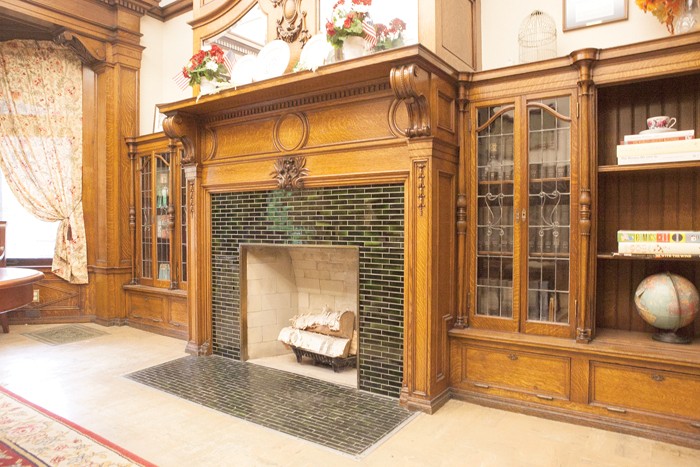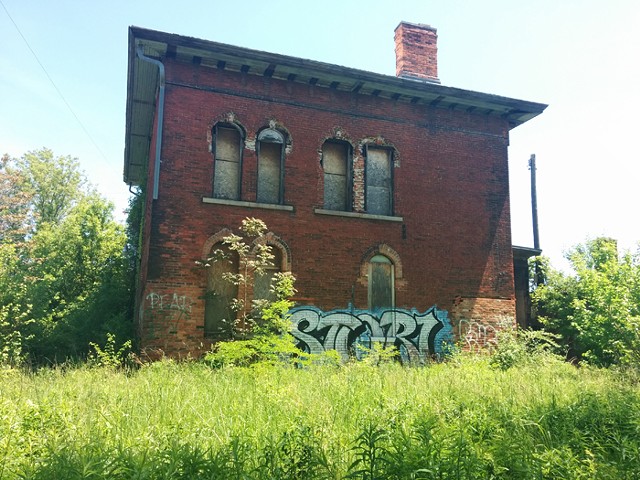A city known for holding a mythological world record for the most bars per capita, as well as for its annual street art fair, Wyandotte is one of the oldest communities Downriver, a place known for its thriving, yet quaint downtown, myriad Catholic churches, and beautiful views of the Detroit River.
Founded in 1854, Wyandotte is also a trove of historical buildings, churches, artifacts, and homes. In fact, the city holds a number of nationally recognized historical sites, including Our Lady of Mount Carmel, an Italian Renaissance-style Catholic church established in 1915, and a rumored-to-be-haunted Odd Fellows Temple built in 1911. Also among those historic sites is the Ford-Bacon House, a dwelling that predates many of the city’s oldest structures.
Before the Ford-Bacon House was even built, the land on which it sits was owned by some of the day’s biggest power players. The four city lots on which it sits were owned by a War of 1812 veteran, Mayor John Biddle. Eber Ward, founder of both the Eureka Iron Company and the village of Wyandotte, later bought the land. A few years and a few owners later, the land belonged to Edward Ford, president of the Michigan Alkali Company and founder of the Ford Plate Glass Company, and his wife, Carrie.
There the couple commissioned the construction of the Queen Anne-style home that still stands today. The Fords hired Detroit-based architectural firm Malcomson & Higginbotham to design the 27-room, 11-fireplace, three-story house. Featuring a bell tower, gabled dormers, a two-story side bay, square brick chimneys, and a wraparound porch with its own hipped roof, it cost $27,000 to build and was completed in 1898. Edward and Carrie Ford only lived there shortly before moving to Toledo in 1900 to be closer to the booming glass industry.
Then bequeathed to Ford’s son Capt. John B. Ford, the home was inhabited by the younger Ford and his family, but also only for a brief time before being given to Capt. Ford’s daughter, Mary Ford Bacon and her husband, Mark Reeves Bacon.
Yes, there are a lot of Fords.
The couple lived in the home until 1942, when Bacon passed away, at which time his wife deeded the property to the Wyandotte Board of Education and henceforth the structure has been the site of the city’s public library.
With only modifications done to flooring and some lighting, much of the Ford-Bacon home remains original. Doorknobs, hearth tiles, stained-glass windows, and woodworking offer insight into the design style prevalent to the period. Beautiful, swooping banisters are fashioned from oak; Ford’s glass company, according to librarian Wallace Hayden, made the leaded, stained-glass windows. Built-in bookcases, coved doorways, curved glass accents, etched radiators, window seats, and high ceilings all complement this beautiful, well-maintained edifice packed with history.
In 1987 the house was designated a Michigan State Historic Site, and 10 years later it was added to the National Register of Historic Places.
With an additional building added on to the back of the Ford-Bacon home, the main portion of the library is now located in the newer annex, while the original structure houses some books, newspapers, and magazines. Open to the public for self-guided tours, the space also offers quiet rooms for personal study, although according to The News Herald, some people have reported the feeling of being watched and a light or two turning on and off of their own volition.
With a vast and detailed history, happenings in the Ford-Bacon library haven’t been scarce. Several times in its history, city officials have attempted to have the building torn down due to the high cost of maintenance and repair, one of the most notable attempts came in 1954 when library director Hazel Adair wrote John Bacon, the estate’s heir, asking that the building be demolished.
In 1973, Marion Kuclo, better known to the public as the witch Gundella, began making appearances as a children’s storyteller at the library. Claiming to be descended from a 15th-century Scottish cult, Kuclo caused a ruckus belonging to a cult and giving salep root to children. Several adults declared she was the devil’s associate, and one pastor claimed she was dangerous.
No doubt the children loved it.
In 1996, President Bill Clinton visited the building as part of his re-election campaign, making a speech in front of the house, signing books for schools and library workers inside one of the home’s many rooms, and reading The Little Engine That Could to a crop of local elementary schoolchildren. According to Hayden, the president also commented on the beauty of the home. A giant library card bearing his autograph is still on display at the library.
Now a stately fixture of the community of Wyandotte, the Ford-Bacon House is part of all metro Detroiters’ history. With special tours taking place the first Saturday of every month at 10 a.m. (that’s the only time you can visit the third floor), the dose of heritage is free to the public.
Pro tip: The carpeted bathtub in the children’s section of the annex is also from the home, having been originally found on the third floor.






